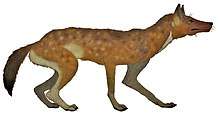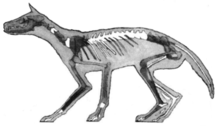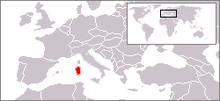Sardinian dhole
The Sardinian dhole (Cynotherium sardous), also known as the Sardinian fox, is an extinct insular canid[1] which was endemic to what is now the Mediterranean islands of Sardinia (Italy) and Corsica (France), which were joined for much of the Pleistocene. It went extinct when humans began to settle on the island.[2] Its scientific name means "dog-beast of Sardinia".

| Sardinian dhole | |
|---|---|
 | |
| Scientific classification | |
| Kingdom: | Animalia |
| Phylum: | Chordata |
| Class: | Mammalia |
| Order: | Carnivora |
| Family: | Canidae |
| Subfamily: | Caninae |
| Tribe: | Canini |
| Genus: | †Cynotherium |
| Species: | †C. sardous |
| Binomial name | |
| †Cynotherium sardous Studiati, 1857 | |
 | |
| Former range (in red) | |
When the ancestor of this canid, a species of the wolf-sized Xenocyon lycaonoides, became confined to the island, its diet became limited to small and fast prey, such as rodents and rabbits. This lack of large prey caused the Sardinian dhole to evolve into a small sized (perhaps 10 kg or 22 lb) canid. This view of Cynotherium as a predator specializing in small, fast prey is supported by an examination of the animal's anatomy. The evolution of short, powerful limbs, a low neck carriage and increased head and neck mobility suggests an animal well suited for stalking and then quickly pouncing on or running down small prey.[1][3]
Despite its common name, Cynotherium sardous is not always listed as a relative of the modern dhole. Recent studies consider the Sardinian dhole a part of the tribe Canini and a relative of the genus Lycaon, which includes the African wild dog and the extinct Lycaon sekowei.[3] As mentioned earlier, some species of Xenocyon are thought to be the ancestor of Cynotherium.[1] Another hypothesis posits that the Sardinian dhole is derived from a late population of Canis arnensis (or Canis mosbachensis).[4] An origin from Xenocyon is supported by Cynotherium malaestai, a species described in 2015 from the Middle Pleistocene of Sardinia, intermediate in morphology between Xenocyon lycaonoides and Cynotherium sardous.[5]
References
- Lyras G.A.; Van der Geer A.E.; Dermitzakis M.; De Vos J. (2006). "Cynotherium sardous, an insular canid (Mammalia: Carnivora) from the Pleistocene of Sardinia (Italy), and its origin". Journal of Vertebrate Paleontology. 26 (3): 735–745. doi:10.1671/0272-4634(2006)26[735:CSAICM]2.0.CO;2.
- Gippoliti, Spartaco & Amori, Giovanni (2006). "Ancient introductions of mammals in the Mediterranean Basin and their implications for conservation". Mammal Review. 36 (1): 37–48. doi:10.1111/j.1365-2907.2006.00081.x.
- Lyras G.; Van der Geer A. (2006). "Adaptations of the Pleistocene island canid Cynotherium sardous (Sardinia, Italy) for hunting small prey". Cranium. 23 (1): 51–60. PDF copy
- Abbazzi L., M. Arca, C. Tuveri & L. Rook (2005). "The endemic canid Cynotherium (Mammalia, Carnivora) from the Pleistocene deposits of Monte Tuttavista (Nuoro, Eastern Sardinia)". Rivista Italiana di Paleontologia e Stratigrafia. 111 (3): 497. Archived from the original on 2014-07-15. Retrieved 2012-12-31.CS1 maint: multiple names: authors list (link)
- Madurell-Malapeira, Joan; Palombo, Maria Rita; Sotnikova, Marina (2015-07-04). "Cynotherium malatestai , sp. nov. (Carnivora, Canidae) from the early middle Pleistocene deposits of Grotta dei Fiori (Sardinia, Western Mediterranean)". Journal of Vertebrate Paleontology. 35 (4): e943400. doi:10.1080/02724634.2014.943400. ISSN 0272-4634.